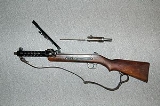
MP34
Encyclopedia
The MP34 is a submachine gun
(SMG) that was manufactured by Waffenfabrik Steyr and used by the Austrian police and subsequently by units of the German army
, including the Waffen SS, in World War II. An exceptionally well-made weapon, it was used by some forces well into the 1970s.
company based in Düsseldorf
. The weapon is similar in design to the MP18
Bergmann, which itself saw service towards the end of World War I.
Restrictions on the manufacture of certain armaments within the 1919 Treaty of Versailles
forbade Germany from manufacturing certain types of weapons, such as light automatic firearms (designated as SMGs with barrels in excess of four inches (102 mm) and magazines holding more than eight rounds). To circumvent the treaty, Rheinmetall acquired the Swiss company Waffenfabrik Solothurn
in 1929 and began secret production of a prototype. What was to become the MP34 was originally designated ‘S1-100’ using the company’s standard naming convention.
Due to the Solothurn company being unsuited for mass production, Rheinmetall took a controlling interest in Waffenfabrik Steyr, an established arms manufacturer in Austria. Weapons manufactured by Steyr were sold via the Zurich
-based trade company Steyr-Solothurn Waffen AG to both the commercial and military markets.
The MP34 was manufactured from the very best materials available and finished to the highest possible standard. It was so well manufactured that it has often been nicknamed the "Rolls Royce
of submachine guns". However, its production costs were extremely high as a consequence.
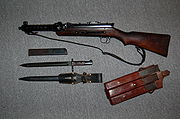
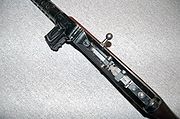
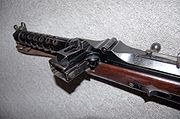
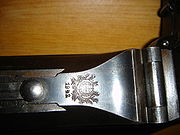 The MP34 was a selective-fire weapon (single shot or full auto), firing in blowback mode with an open bolt. The return spring was located in the wooden stock and was linked to the bolt via a long push rod, attached pivotally to the rear of the bolt. Easy access to the bolt and trigger assembly was via a hinged top cover which opened up and forward by depressing two release catches. This makes cleaning procedures very easy to perform.
The MP34 was a selective-fire weapon (single shot or full auto), firing in blowback mode with an open bolt. The return spring was located in the wooden stock and was linked to the bolt via a long push rod, attached pivotally to the rear of the bolt. Easy access to the bolt and trigger assembly was via a hinged top cover which opened up and forward by depressing two release catches. This makes cleaning procedures very easy to perform.
On the left-hand side of the stock was a sliding fire selector switch (marked by letters T and S). Initial production runs of the gun had a Schmeisser-style (Hugo Schmeisser
) bolt-locking safety (similar to the MP40
) in the form of hook-shaped cut which was used to engage the bolt handle when the bolt was cocked (which was notoriously unsafe). Later models included a manual safety on the top cover, just in front of the rear sight. This safety could lock the weapon in both a cocked or closed position.
32 or 20 round box magazines were fed in from the left side and the magazine housing was angled slightly forward to improve cartridge feeding to prevent jams. Additionally, the same magazine housing incorporated a magazine refilling feature. An empty magazine could be inserted from underneath and locked in place. From above stripper clips (of 8 rounds each) could be fed into the magazines.
All MP34s were equipped with a wooden stock with a semi-pistol grip. The barrel was enclosed into a perforated cooling jacket, and had a bayonet-fixing lug on the right-hand side. Front (hooded) and rear rifle-type sights were fitted – the latter marked from 100 to 500 meters.
The weapon could be fitted with a detachable bipod for stability.
For the South American markets, Steyr produced a version of the S1-100 in .45 ACP
calibre; this derivation can be identified by an additional pistol grip under the stock.
The Austrian army adopted the Steyr-Solothurn S1-100 as the Steyr MP34, chambered for the powerful 9 x 25 Mauser
ammunition.
With the 1938 Anschluss
between Germany and Austria, the German Army acquired most of available MP30s and MP34s. A number were then re-barrelled to chamber 9 x 19 ammunition and issued to German troops as the MP34(ö) - Maschinenpistole 34 österreichisch (literally "Machine-pistol 34, austrian"). Production of the MP34 ceased in mid-1940, and manufacturing lines at Steyr moved over to the production of the MP40 – a much simpler designed weapon and far less expensive to produce than the MP34. As a substitute standard small arm, it had a relatively short combat service once quantities of the MP38 became available, though some MP34s were used by Waffen SS units in the early stages of the war in Poland and France. It was then allocated to line-of-communications and reserve units, including military police and feldgendarmerie
detachments.
Portugal
bought in small quantities the .45 ACP
version and was adopted as Pistola-metralhadora 11,43mm m/935. Portgual also purchased small quantities of the S1-100 in 7.65 mm Luger calibre in 1938, and the weapon was adopted as the Pistola-metralhadora 7,65 mm m/938 Steyer submachine gun. In 1941 and 1942, larger numbers of 9mm MP34 guns were delivered to Portugal by Germany. In Portuguese service, the 9mm MP34 was known as the Pistola-metralhadora 9 mm m/942 Steyer. Many m/942 guns carry a Portuguese crest just forward of the safety mechanism in combination with Waffenamt
(WaA) markings. The m/942 remained in service with Portuguese Army into the 1950s, and was used until the 1970s by paramilitary and security forces in Portugal's overseas African colonies during the Portuguese Colonial Wars.
Submachine gun
A submachine gun is an automatic carbine, designed to fire pistol cartridges. It combines the automatic fire of a machine gun with the cartridge of a pistol. The submachine gun was invented during World War I , but the apex of its use was during World War II when millions of the weapon type were...
(SMG) that was manufactured by Waffenfabrik Steyr and used by the Austrian police and subsequently by units of the German army
German Army
The German Army is the land component of the armed forces of the Federal Republic of Germany. Following the disbanding of the Wehrmacht after World War II, it was re-established in 1955 as the Bundesheer, part of the newly formed West German Bundeswehr along with the Navy and the Air Force...
, including the Waffen SS, in World War II. An exceptionally well-made weapon, it was used by some forces well into the 1970s.
History
The MP34 was based on a design for the MP18 by the RheinmetallRheinmetall
Rheinmetall AG is a German automotive and defence company with factories in Düsseldorf, Kassel and Unterlüß. The company has a long tradition of making guns and artillery pieces...
company based in Düsseldorf
Düsseldorf
Düsseldorf is the capital city of the German state of North Rhine-Westphalia and centre of the Rhine-Ruhr metropolitan region.Düsseldorf is an important international business and financial centre and renowned for its fashion and trade fairs. Located centrally within the European Megalopolis, the...
. The weapon is similar in design to the MP18
MP18
The MP18.1 manufactured by Theodor Bergmann Waffenbau Abteilung was the first practical submachine gun used in combat. It was introduced into service in 1918 by the German Army during World War I as the primary weapon of the Stosstruppen, assault groups specialized in trench combat...
Bergmann, which itself saw service towards the end of World War I.
Restrictions on the manufacture of certain armaments within the 1919 Treaty of Versailles
Treaty of Versailles
The Treaty of Versailles was one of the peace treaties at the end of World War I. It ended the state of war between Germany and the Allied Powers. It was signed on 28 June 1919, exactly five years after the assassination of Archduke Franz Ferdinand. The other Central Powers on the German side of...
forbade Germany from manufacturing certain types of weapons, such as light automatic firearms (designated as SMGs with barrels in excess of four inches (102 mm) and magazines holding more than eight rounds). To circumvent the treaty, Rheinmetall acquired the Swiss company Waffenfabrik Solothurn
Solothurn
The city of Solothurn is the capital of the Canton of Solothurn in Switzerland. The city also comprises the only municipality of the district of the same name.-Pre-roman settlement:...
in 1929 and began secret production of a prototype. What was to become the MP34 was originally designated ‘S1-100’ using the company’s standard naming convention.
Due to the Solothurn company being unsuited for mass production, Rheinmetall took a controlling interest in Waffenfabrik Steyr, an established arms manufacturer in Austria. Weapons manufactured by Steyr were sold via the Zurich
Zürich
Zurich is the largest city in Switzerland and the capital of the canton of Zurich. It is located in central Switzerland at the northwestern tip of Lake Zurich...
-based trade company Steyr-Solothurn Waffen AG to both the commercial and military markets.
The MP34 was manufactured from the very best materials available and finished to the highest possible standard. It was so well manufactured that it has often been nicknamed the "Rolls Royce
Rolls-Royce (car)
This a list of Rolls-Royce motor cars and includes vehicles produced by:*Rolls-Royce Limited *Rolls-Royce Motors , which was owned by Vickers between 1980 and 1998, and after that by Volkswagen...
of submachine guns". However, its production costs were extremely high as a consequence.
Operation




On the left-hand side of the stock was a sliding fire selector switch (marked by letters T and S). Initial production runs of the gun had a Schmeisser-style (Hugo Schmeisser
Hugo Schmeisser
Hugo Schmeisser was a German developer of infantry weapons in the 20th century.Schmeisser was born in Jena, Saxe-Weimar. His father, Louis Schmeisser , was one of the best-known weapons designers in Europe...
) bolt-locking safety (similar to the MP40
MP40
The MP 38 and MP 40 , often called Schmeisser, were submachine guns developed in Nazi Germany and used extensively by paratroopers, tank crews, platoon and squad leaders, and other troops during World War II.-Development:The MP 40 descended from its predecessor, the MP 38, which was in turn based...
) in the form of hook-shaped cut which was used to engage the bolt handle when the bolt was cocked (which was notoriously unsafe). Later models included a manual safety on the top cover, just in front of the rear sight. This safety could lock the weapon in both a cocked or closed position.
32 or 20 round box magazines were fed in from the left side and the magazine housing was angled slightly forward to improve cartridge feeding to prevent jams. Additionally, the same magazine housing incorporated a magazine refilling feature. An empty magazine could be inserted from underneath and locked in place. From above stripper clips (of 8 rounds each) could be fed into the magazines.
All MP34s were equipped with a wooden stock with a semi-pistol grip. The barrel was enclosed into a perforated cooling jacket, and had a bayonet-fixing lug on the right-hand side. Front (hooded) and rear rifle-type sights were fitted – the latter marked from 100 to 500 meters.
The weapon could be fitted with a detachable bipod for stability.
Service
In 1930, the Austrian police accepted the S1-100 as the Steyr MP30, chambered for then standard Austrian 9 x 23 Steyr pistol rounds. The weapon was also exported to Chile, Bolivia, El Salvador, Uruguay and Venezuela, and was sold in limited numbers to China, in 7.63 x 25 Mauser calibre.For the South American markets, Steyr produced a version of the S1-100 in .45 ACP
.45 ACP
The .45 ACP , also known as the .45 Auto by C.I.P., is a cartridge designed by John Browning in 1904, for use in his prototype Colt semi-automatic .45 pistol and eventually the M1911 pistol adopted by the United States Army in 1911.-Design and history:The U.S...
calibre; this derivation can be identified by an additional pistol grip under the stock.
The Austrian army adopted the Steyr-Solothurn S1-100 as the Steyr MP34, chambered for the powerful 9 x 25 Mauser
9x25mm Mauser
The 9x25mm Mauser was a cartridge developed for the Mauser C96 service pistol. The cartridge was first produced by DWM in 1907 and later by German munitions makers Geco and RWS through World War II...
ammunition.
With the 1938 Anschluss
Anschluss
The Anschluss , also known as the ', was the occupation and annexation of Austria into Nazi Germany in 1938....
between Germany and Austria, the German Army acquired most of available MP30s and MP34s. A number were then re-barrelled to chamber 9 x 19 ammunition and issued to German troops as the MP34(ö) - Maschinenpistole 34 österreichisch (literally "Machine-pistol 34, austrian"). Production of the MP34 ceased in mid-1940, and manufacturing lines at Steyr moved over to the production of the MP40 – a much simpler designed weapon and far less expensive to produce than the MP34. As a substitute standard small arm, it had a relatively short combat service once quantities of the MP38 became available, though some MP34s were used by Waffen SS units in the early stages of the war in Poland and France. It was then allocated to line-of-communications and reserve units, including military police and feldgendarmerie
Feldgendarmerie
The Feldgendarmerie were the uniformed military police units of the armies of the German Empire from the mid 19th Century until the conclusion of World War II.- Early history :...
detachments.
Portugal
Portugal
Portugal , officially the Portuguese Republic is a country situated in southwestern Europe on the Iberian Peninsula. Portugal is the westernmost country of Europe, and is bordered by the Atlantic Ocean to the West and South and by Spain to the North and East. The Atlantic archipelagos of the...
bought in small quantities the .45 ACP
.45 ACP
The .45 ACP , also known as the .45 Auto by C.I.P., is a cartridge designed by John Browning in 1904, for use in his prototype Colt semi-automatic .45 pistol and eventually the M1911 pistol adopted by the United States Army in 1911.-Design and history:The U.S...
version and was adopted as Pistola-metralhadora 11,43mm m/935. Portgual also purchased small quantities of the S1-100 in 7.65 mm Luger calibre in 1938, and the weapon was adopted as the Pistola-metralhadora 7,65 mm m/938 Steyer submachine gun. In 1941 and 1942, larger numbers of 9mm MP34 guns were delivered to Portugal by Germany. In Portuguese service, the 9mm MP34 was known as the Pistola-metralhadora 9 mm m/942 Steyer. Many m/942 guns carry a Portuguese crest just forward of the safety mechanism in combination with Waffenamt
Waffenamt
Waffenamt was the German Army Weapons Agency. It was the centre for research and development of Germany and also during the Third Reich for weapons, ammunition and army equipment to the German Reichswehr and later Wehrmacht...
(WaA) markings. The m/942 remained in service with Portuguese Army into the 1950s, and was used until the 1970s by paramilitary and security forces in Portugal's overseas African colonies during the Portuguese Colonial Wars.

